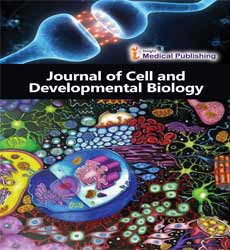Totipotency: An Overview
Peter Johnson*
Federal University of Rio Grande doSul, Porto Alegre, Brazil
- *Corresponding Author:
- Peter Johnson
Federal University of Rio Grande doSul, Porto Alegre, Brazil
E-mail: peterjoh@99yahoo.com
Received Date: September 02, 2021; Accepted Date: September 17, 2021; Published Date: September 27, 2021
Citation: Johnson P (2021) Totipotency: An Overview. J Cell Dev Biol. Vol.5 No.5:10.
Commentary
The medical dictionary administered by the National Institutes of Health gives two contrasting definitions for the term totipotent: “capable of developing into an entire organism” or “differentiating into any of its cells or tissues. Much of the confusion surrounding the term totipotency centers on the important differences between these two definitions. A one-cell embryo (zygote) is “totipotent” in both senses; yet, some authors characterize tumors and stem cells as “totipotent,” based only on the second definition (ie, the power of those cells to supply a good range of cell types).The difference between these two definitions isn't trivial. Producing a mature organism requires the power to both generate all the cells of the body and to arrange them during a specific temporal and spatial sequence, that is, to undergo a coordinated process of development. Totipotency during this strict sense is demonstrated by the power of an isolated cell to supply a fertile, adult individual. Consequently, a cell that's totipotent is additionally a one-cell embryo; that's, a cell that's capable of generating a globally coordinated developmental sequence.
While stem cells, tumors, and embryos have many molecular features in common, embryos are clearly organisms. Embryos develop during a predictable manner toward a species-specific adult form (human embryos don't mature into mice, monkeys, or tumors). Embryos repair injury. They adapt to changing environmental conditions. most significantly, they show coordinated interactions between parts (molecules, cells, tissues, structures, and organs) that promote the survival, health, and continued development of the organism as a whole; that's, interactions that are characteristic of “an individual constituted to hold on the activities of life by means of organs separate in function but mutually dependent: a living being, In contrast, stem cells and tumors don't produce cells or structures within the functionally integrated progression that's characteristic of an organism. They are unable of development. The ability to supply an orchestrated developmental sequence shouldn't be misconstrued as some quite mystical element that's merely attributed to an embryo. The fact that the embryo undergoes a self-directed process of maturation is entirely a matter of empirical observation; embryos construct themselves. Scientists tend to look at this developmental capability as a series of cellular/molecular events. Others may view human development in additional spiritual or poetic terms. But neither of those views alters the scientific facts; embryos manifest a singular molecular composition and pattern of behavior that's characteristic of an organism (ie, a living being) that has not been observed in tumors or other human cells.Regardless how individuals or societies ultimately weigh the worth of the embryo relative to the worth of research project , it's important to understand that altogether cases, the moral consideration given to human embryos doesn't reflect the status they're going to achieve at some point within the future (i.e., what they're going to mature into). If this was the case, then there might be no possible objection to embryodestructive research since, by definition, adult status isn't attained in such situations. Rather, ethical consideration is given to human embryos supported the status they already possess; that's, their unique and fully operative ability to function as a person's organism. Therefore, ethical controversy regarding totipotent human cells only concerns cells that are totipotent within the strict, organismal sense; that's, a cell that's a person's embryo. The term totipotent describes the properties of a private cell (not a gaggle of cells) with the two meanings of this term roughly like the progressive restriction in potential cells exhibit during normal development. At the expanded blastocyst stage, cells in specific regions of the embryo are restricted to supply only a subset of the cells observed at more-mature stages. Restrictions in potency occur gradually as development proceeds, with the power to independently initiate a developmental sequence (ie, totipotency within the first sense) being lost relatively early during development, and individual cells of the late morula and early blastocyst producing a wider range of derivatives than cells at the expanded blastocyst stage.
Open Access Journals
- Aquaculture & Veterinary Science
- Chemistry & Chemical Sciences
- Clinical Sciences
- Engineering
- General Science
- Genetics & Molecular Biology
- Health Care & Nursing
- Immunology & Microbiology
- Materials Science
- Mathematics & Physics
- Medical Sciences
- Neurology & Psychiatry
- Oncology & Cancer Science
- Pharmaceutical Sciences
